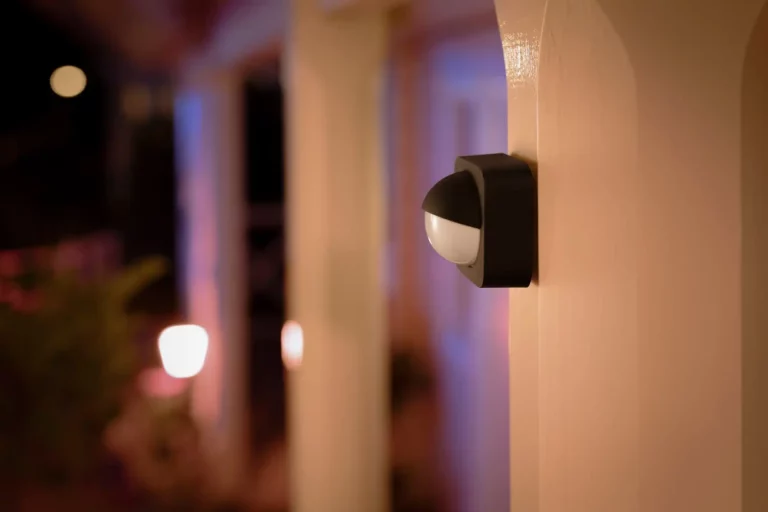Introduction
How Motion Sensor Works: Motion sensors are electronic devices that detect and measure physical movement in their surroundings. They employ a range of technologies and principles to accomplish this task, each with its unique advantages and applications.
One prevalent type of motion sensor is the passive infrared (PIR) sensor, often found in security systems and automatic lighting. PIR sensors work by detecting infrared radiation emitted by objects in their field of view. All objects with a temperature above absolute zero emit infrared radiation, including humans and animals. The sensor contains a pyroelectric material that generates an electrical charge when exposed to changes in infrared radiation, such as when a warm body moves across its range. Charge change causes an electrical signal that can be perceived as motion.
Another type of motion sensor is the ultrasonic sensor, commonly used in parking assistance systems and robotics. Ultrasonic sensors utilize sound waves to detect motion. They emit high-frequency sound pulses and measure the time it takes for the sound waves to bounce back after hitting an object. By calculating the time difference between emitted and received signals, the sensor can determine the distance to the object and detect any movement based on changes in the reflected sound waves and laser-based sensors that employ laser beams to detect movement by measuring the time it takes for the beam to reach an object and return.

How do motion sensors work in the dark?
Since none of the aforementioned motion sensors use pictures to detect motion, they work in complete darkness. PIR motion sensors measure infrared levels instead of pictures. Ultrasonic motion sensors also don’t need images.
Security, automatic lighting, and motion detection systems use passive infrared (PIR) sensors. PIR sensors detect infrared radiation from objects rather than visible light, thus they function well in the dark. All items above absolute zero, including humans and animals, emit infrared light.
PIR sensors are grids of infrared sensors. Each sensor detects heat signature variations within its range. A warm body moving across the field of vision changes the measured heat patterns, activating the PIR sensor to transmit a signal and activate the intended reaction, such as lights or an alert. Thus, PIR sensors work effectively in light and dark.
Microwave motion sensors also operate well in the dark. PIR sensors detect heat, but microwave sensors emit continuous microwave impulses and analyze their reflection patterns. The microwave reflection pattern changes when an object enters the sensor’s range. This change is detected as motion by the sensor.
Microwave sensors don’t need ambient light. They can detect movements in complete darkness or bright light. However, microwave sensors may detect non-living objects like trees and walls and may use more electricity than other motion sensor technologies.
Ultrasonic sensors measure distance and motion using sound waves. They measure the bounce time of high-frequency sound pulses impacting an object. Because they don’t need visible light, ultrasonic sensors can work in the dark like microwave sensors.
Why do we need motion sensor?
Building security devices like motion sensors measure and detect movement. Usually utilized after hours, these devices inform owners of unlawful movement in restricted regions.
Motion sensors serve security. Security systems employ motion sensors to detect and respond to unauthorized movement. The first line of defense is alarms, notifications, or security cameras when motion is detected in prohibited areas or periods. Motion sensors keep criminals away from homes, businesses, and valuables.
Motion sensors are essential for promoting energy efficiency in our homes and buildings. In automatic lighting systems, motion sensors detect movement within a room and activate the lights. This eliminates the need for manual switches and ensures that lights are only on when needed.
Motion sensors switch off lights when no movement is detected, saving energy. Similarly, in commercial settings, motion sensors can control HVAC systems, turning them off or adjusting the temperature settings when an area is unoccupied, resulting in significant energy savings.
Motion sensors contribute to convenience and automation in various ways. In our homes, motion-activated lights can illuminate our path as we enter a room, eliminating the need to fumble for switches in the dark. Motion-activated faucets and toilets in public restrooms provide hands-free operation, promoting hygiene and reducing water wastage.
Motion sensors also play a vital role in home automation systems, enabling seamless control of various devices, such as opening doors, adjusting blinds, or playing music, simply by detecting our presence or specific gestures.
How far can motion sensors reach?
Basic motion detectors detect objects 6.5–70 feet away. You can buy ones that detect further if needed. Optical, infrared, and radio wave motion detectors are useful in diverse contexts.
Motion sensors’ range depends on their design and technology. Different motion sensors use different detecting methods, each with its own strengths and weaknesses.
Passive Infrared (PIR) sensors detect infrared radiation variations ranging from 20 to 30 feet (6 to 9 meters). Some high-quality PIR sensors can reach 50 feet (15 meters).
PIR sensors have a shorter range than microwave sensors, which examine microwave reflection patterns. They can detect motion 30–100 feet (9–30 meters) or farther, depending on the model.
Sound-wave-based ultrasonic motion sensors have a shorter range than microwave sensors. They work between 10–30 feet (3–9 meters).
Motion-detecting laser sensors can reach several hundred feet. These sensors are employed in outdoor and long-range applications.
Motion sensor range is also affected by the environment. Walls, furniture, and plants can block sensor detection range and diminish performance. Certain motion sensors are also affected by humidity, temperature, and air quality.
Motion sensors frequently have sensitivity controls. Users can customize the detecting range by altering sensitivity. Higher sensitivity settings may increase range but also increase false alarms from slight movements or environmental influences. Balance sensitivity and range for optimal performance.
Do motion sensors use light?
Motion sensors can be triggered by light. Turning on the light rapidly changes the electromagnetic spectrum sensed by light-based detectors like PIR or area reflective sensors. Change can be a movement.
One of the most prevalent motion sensors in security systems and automatic lighting is passive infrared (PIR). Light is not immediately detected by PIR sensors. Instead, they measure object infrared radiation.
Everything above absolute zero emits infrared radiation, including humans and animals. PIR sensors detect heat signature changes via a grid of infrared sensors.
A warm body moving across the field of vision changes the heat patterns, activating the PIR sensor to send a signal and activate the intended response. Thus, PIR sensors detect infrared radiation from objects rather than visible light.
Other motion sensors, including microwave sensors, don’t use light. They continuously emit microwaves and analyze reflections. The microwave reflection pattern changes when an object enters the sensor’s range.
This change is detected as motion by the sensor. Microwave sensors can detect movement in bright and dark settings.
Motion detection with ultrasonic sensors does not need light. They measure distance and movement via sound waves. Ultrasonic sensors monitor sound wave bounce after impacting an item. Sound wave return time changes as an object enters the sensor’s range. The sensor perceives this fluctuation as motion. Ultrasonic sensors are utilized in robotics and parking assistance systems to operate without light.
Who uses motion sensors?
Electronic motion sensors measure movement. Home and business security systems, phones, paper towel dispensers, game consoles, and VR systems use motion sensors.
Home automation and security use motion sensors. Residential security systems use them to detect illegal activity and alert homeowners or monitoring centers. Automatic lighting systems turn on when motion is detected, saving electricity while convenient. Motion sensors can automate smart home functions including door opening, temperature control, and entertainment.
Motion sensors are crucial to commercial security and energy management. Commercial security systems monitor restricted areas, identify illicit entrance, and activate alarms via motion sensors. They can be integrated with surveillance cameras to improve monitoring.
For energy management, motion sensors control lighting and HVAC systems to turn on only when needed and change temperatures based on occupancy. It optimizes energy use and lowers operational costs.
Industry and manufacturing use motion sensors for safety, efficiency, and automation. Machine automation in factories uses motion sensors to identify things on assembly lines and take action. They also stop machines if a worker reaches a dangerous location. Robots and automation require motion sensors to perceive and respond to their surroundings, navigate obstacles, and perform precise jobs.
Do motion sensors need power?
Yes, wireless motion sensors have batteries. All wireless sensors use batteries to communicate with the panel. Wireless motion sensors also require power for basic operation. However, hardwired sensors do not require batteries, as they can use power that is provided from the panel.
Batteries power some motion sensors. Battery-powered motion sensors are portable and flexible. Installation is easy in places where electrical wiring isn’t possible or practical. Wireless systems, outdoor security cameras, and isolated regions without power use battery-powered motion sensors.
The batteries used to power motion sensors can vary depending on the specific model and requirements. They can range from standard alkaline batteries to rechargeable batteries, such as lithium-ion or nickel-metal hydride (NiMH) batteries. The battery life can vary depending on factors such as the sensor’s power consumption, detection frequency, and the type and quality of the batteries used.
Solar energy powers solar-powered motion sensors. They have solar panels that turn sunlight into electricity. The motion sensor is powered by solar energy stored in batteries or capacitors.
Outdoor security lighting, surveillance cameras, and environmental monitoring systems use solar-powered motion sensors. They’re eco-friendly and cost-effective because they use renewable energy.
It is worth noting that some motion sensors may use a combination of power sources. For example, they may be connected to an electrical power source but also have a backup battery in case of a power outage. This ensures continuous operation even during power disruptions.
Can motion sensor detect speed?
Microwave motion sensors provide low-level voltage signals with Doppler frequencies that indicate vehicle speed. We use this signal to determine vehicle length and speed.
Ultrasonic and laser-based motion sensors can estimate distance by measuring the time it takes a signal to travel to and return from an object. You can measure an object’s speed by measuring its distance over time. Calculate the moving object’s average speed by computing distance change over time.
However, time-of-flight speed estimation accuracy depends on the sensor’s precision and frequency, the object’s velocity, and environmental factors like air density and interference that may affect the signal’s travel time.
Radar-based motion sensors can indirectly determine speed via the Doppler effect. The relative motion between the source and object causes the Doppler effect, which changes the frequency of emitted and received waves.
Motion sensors measure speed by examining the frequency change of reflected waves. This method demands accurate and specialized technology, usually found in radar-based systems, and may not work for all motion sensors.
Motion sensors can measure speed, but there are restrictions. The sensor’s resolution, frequency, distance from the moving object, and object velocity affect speed estimation accuracy.
Who invented motion sensors?
Samuel Bagno
Samuel Bagno invented the first motion sensor in the 1940s using WWII technology. Bagno invented a room motion detector using ultrasonic waves and the Doppler effect using his military radar skills.
In the 1970s, Donald L. Bitzer and Gene Slottow, American engineers and inventors, developed the plasma display panel (PDP), which later played a significant role in the development of motion sensors. PDP technology utilized electrodes to excite gas molecules in a plasma state, producing light. Touchscreens and digital signage use passive matrix sensors for motion detection thanks to this idea.
Amiram Roth-Deblon, an Israeli engineer and inventor, made significant contributions to motion sensor technology. In the 1980s, he developed the microwave sensor, which utilized continuous-wave radar technology to detect motion. Roth-Deblon’s invention paved the way for the use of microwave sensors in various applications, including automatic door openers, security systems, and occupancy detection.
Steve Mann, a Canadian inventor and researcher, contributed to the advancement of motion sensor technology in the 1990s. He developed the Wearable Wireless Webcam, a head-mounted camera system that could detect and track motion in real-time. Mann’s work on motion detection and computer vision technologies laid the groundwork for applications such as surveillance, augmented reality, and gesture-based interactions.
Albert Falck, a Swedish inventor and entrepreneur, made significant strides in motion sensor technology in the early 2000s. He developed the first consumer-grade passive infrared (PIR) motion sensors for home security systems. Falck’s innovative approach led to the widespread adoption of motion sensors in residential environments, enhancing security and automation.

Conclusion
Security systems and automatic lighting use passive infrared (PIR) sensors to detect object-emitted infrared radiation. Ultrasonic sensors, on the other hand, employ sound waves to measure the time it takes for waves to bounce back from objects, enabling the detection of movement and distance. Microwave sensors analyze microwave reflection patterns, while laser-based sensors rely on laser beams to detect motion.
Once motion is detected, these sensors can trigger various actions, such as sounding an alarm, activating lights, or initiating automated processes. This capability has made motion sensors invaluable in fields like security, home automation, robotics, gaming, and many others. However, it’s important to recognize that each type of motion sensor has its own strengths and limitations. PIR sensors, for instance, may be affected by environmental factors or limited in their ability to detect slow or small movements. Ultrasonic sensors, while effective in certain scenarios, may struggle with accuracy in complex environments.
As technology continues to advance, we can anticipate further improvements in motion sensor capabilities. Innovations such as machine learning algorithms, advanced image recognition, and sensor fusion techniques have the potential to enhance the accuracy, reliability, and responsiveness of motion sensors. Understanding how motion sensors work allows us to envision their future possibilities. From improved security systems that can differentiate between humans and other sources of infrared radiation to robotics systems with enhanced motion detection for precise navigation, motion sensors will continue to shape and transform various aspects of our lives.

